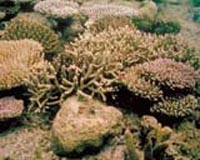| . |  |
. |
San Francisco CA (SPX) Apr 01, 2010 Scientists have presented a design strategy to produce the long-sought artificial leaf, which could harness Mother Nature's ability to produce energy from sunlight and water in the process called photosynthesis. The new recipe, based on the chemistry and biology of natural leaves, could lead to working prototypes of an artificial leaf that capture solar energy and use it efficiently to change water into hydrogen fuel, they stated. Their report was scheduled for the 239th National Meeting of the American Chemical Society (ACS), being held here this week. It was among more than 12,000 scientific reports scheduled for presentation at the meeting, one of the largest scientific gatherings of 2010. "This concept may provide a new vista for the design of artificial photosynthetic systems based on biological paradigms and build a working prototype to exploit sustainable energy resources," Tongxiang Fan, Ph.D. and colleagues Di Zhang, Ph.D. and Han Zhou, Ph.D., reported, They are with the State Key Lab of Matrix Composites at Shanghai Jiaotong University, Shanghai, China. Fan pointed out that using sunlight to split water into its components, hydrogen and oxygen, is one of the most promising and sustainable tactics to escape current dependence on coal, oil, and other traditional fuels. When burned, those fuels release carbon dioxide, the main greenhouse gas. Combustion of hydrogen, in contrast, forms just water vapor. That appeal is central to the much-discussed "Hydrogen Economy," and some auto companies, such as Toyota, have developed hydrogen-fueled cars. Lacking, however, is a cost-effective sustainable way to produce hydrogen. With that in mind, Fan and co-workers decided to take a closer look at the leaf, nature's photosynthetic system, with plans to use its structure as a blueprint for their next generation of artificial systems. Not too surprisingly, the structure of green leaves provides them an extremely high light-harvesting efficiency. Within their architecture are structures responsible focusing and guiding of solar energy into the light-harvesting sections of the leaf, and other functions. The scientists decided to mimic that natural design in the development of a blueprint for artificial leaf-like structures. It led them to report their recipe for the "Artificial Inorganic Leaf" (AIL), based on the natural leaf and titanium dioxide (TiO2) - a chemical already recognized as a photocatalyst for hydrogen production. The scientists first infiltrated the leaves of Anemone vitifolia - a plant native to China - with titanium dioxide in a two-step process. Using advanced spectroscopic techniques, the scientists were then able to confirm that the structural features in the leaf favorable for light harvesting were replicated in the new TiO2 structure. Excitingly, the AIL are eight times more active for hydrogen production than TiO2 that has not been "biotemplated" in that fashion. AILs also are more than three times as active as commercial photo-catalysts. Next, the scientists embedded nanoparticles of platinum into the leaf surface. Platinum, along with the nitrogen found naturally in the leaf, helps increase the activity of the artificial leaves by an additional factor of ten. In his ACS presentation, Fan reported on various aspects of Artificial Inorganic Leaf production, their spectroscopic work to better understand the macro- and microstructure of the photocatalysts, and their comparison to previously reported systems. The activity of these new "leaves", are significantly higher than those prepared with classic routes. Fan attributes these results to the hierarchical structures derived from natural leaves: "Our results may represent an important first step towards the design of novel artificial solar energy transduction systems based on natural paradigms, particularly based on exploring and mimicking the structural design. Nature still has much to teach us, and human ingenuity can modify the principles of natural systems for enhanced utility."
Share This Article With Planet Earth
Related Links American Chemical Society Darwin Today At TerraDaily.com
 New Mathematical Model Helps Biologists Understand How Coral Dies In Warming Waters
New Mathematical Model Helps Biologists Understand How Coral Dies In Warming WatersIthaca NY (SPX) Mar 31, 2010 Cornell University researchers have found a new tool to help marine biologists better grasp the processes under the sea: They have created mathematical models to unveil the bacterial community dynamics behind afflictions that bleach and kill coral. (Public Library of Science - Biology, March 30, 2010.) Warming waters are triggering coral bleaching and disease in the Caribbean, Indian Ocean ... read more |
|
| The content herein, unless otherwise known to be public domain, are Copyright 1995-2010 - SpaceDaily. AFP and UPI Wire Stories are copyright Agence France-Presse and United Press International. ESA Portal Reports are copyright European Space Agency. All NASA sourced material is public domain. Additional copyrights may apply in whole or part to other bona fide parties. Advertising does not imply endorsement,agreement or approval of any opinions, statements or information provided by SpaceDaily on any Web page published or hosted by SpaceDaily. Privacy Statement |